Energy Cost Optimisation in a Wastewater Treatment Plant by Balancing On-Site Electricity Generation with Plant Demand
Abstract
1. Introduction
2. Materials and Methods
2.1. Case Study
2.2. Energy Price
2.3. The Concept of Electricity Demand-Supply Balancing
2.3.1. Setting the Generators’ Power
2.3.2. Determination of the Total Power Set-Point
2.4. Implementation
- The primary generator, which operates at the low tariff in state L1, switches to L2 when the volume in the storage tank is greater than 30%.
- From L2, it returns to L1 when the volume falls below 10%, or it switches from L2 to L3 when the volume rises above 85%.
- From L3, it returns to L2 when the volume falls below 15%, and the pressure in the storage tank falls below 0.8 mbar for 15 min.
- Similar conditions also apply for L4 and for operation in high tariffs. The transitions marked in red in Figure 6 apply from any state to L4 (or H4) when the pressure rises above 2.5 mbar for 2 min.
3. Results
3.1. Initial Operation
3.2. Operation After Implementation of the Dynamic Control
3.3. Impact of the Proposed Control
4. Discussion
5. Conclusions
Supplementary Materials
Author Contributions
Funding
Data Availability Statement
Conflicts of Interest
References
- Campana, P.E.; Mainardis, M.; Moretti, A.; Cottes, M. 100% renewable wastewater treatment plants: Techno-economic assessment using a modelling and optimization approach. Energy Convers. Manag. 2021, 239, 114214. [Google Scholar] [CrossRef]
- Riley, D.M.; Tian, J.; Güngör-Demirci, G.; Phelan, P.; Villalobos, J.R.; Milcarek, R.J. Techno-Economic Assessment of CHP Systems in Wastewater Treatment Plants. Environments 2020, 7, 74. [Google Scholar] [CrossRef]
- Tsalas, N.; Golfinopoulos, S.K.; Samios, S.; Katsouras, G.; Peroulis, K. Optimization of Energy Consumption in a Wastewater Treatment Plant: An Overview. Energies 2024, 17, 2808. [Google Scholar] [CrossRef]
- Maktabifard, M.; Zaborowska, E.; Makinia, J. Achieving energy neutrality in wastewater treatment plants through energy savings and enhancing renewable energy production. Rev. Environ. Sci. Biotechnol. 2018, 17, 655–689. [Google Scholar] [CrossRef]
- Åmand, L.; Olsson, G.; Carlsson, B. Aeration control—A review. Water Sci. Technol. 2013, 67, 2374–2398. [Google Scholar] [CrossRef]
- Gu, Y.; Li, Y.; Yuan, F.; Yang, Q. Optimization and control strategies of aeration in WWTPs: A review. J. Clean. Prod. 2023, 418, 138008. [Google Scholar] [CrossRef]
- Monday, C.; Zaghloul, M.S.; Krishnamurthy, D.; Achari, G.A. Review of AI-Driven Control Strategies in the Activated Sludge Process with Emphasis on Aeration Control. Water 2024, 16, 305. [Google Scholar] [CrossRef]
- Brok, N.B.; Munk-Nielsen, T.; Madsen, H.; Stentoft, P.A. Unlocking energy flexibility of municipal wastewater aeration using predictive control to exploit price differences in power markets. Appl. Energy 2020, 280, 115965. [Google Scholar] [CrossRef]
- Liu, Q.; Dereli, R.K.; Flynn, D.; Casey, E. Demand response through reject water scheduling in water resource recovery facilities: A demonstration with BSM2. Water Res. 2021, 188, 116516. [Google Scholar] [CrossRef]
- Aymerich, I.; Rieger, L.; Sobhani, R.; Rosso, D.; Corominas, L. The difference between energy consumption and energy cost: Modelling energy tariff structures for water resource recovery facilities. Water Res. 2015, 81, 113–123. [Google Scholar] [CrossRef]
- Firouzian, M.; Stenstrom, M.K.; Rosso, D. Effects of power tariffs and aeration dynamics on the expansion of water resource recovery facilities. J. Clean. Prod. 2022, 337, 130385. [Google Scholar] [CrossRef]
- Ali, S.M.H.; Lenzen, M.; Sack, F.; Yousefzadeh, M. Electricity generation and demand flexibility in wastewater treatment plants: Benefits for 100% renewable electricity grids. Appl. Energy 2020, 268, 114960. [Google Scholar] [CrossRef]
- Liu, Q.; Li, R.; Dereli, R.K.; Flynn, D.; Casey, E. Water resource recovery facilities as potential energy generation units and their dynamic economic dispatch. Appl. Energy 2022, 318, 119199. [Google Scholar] [CrossRef]
- Kirchem, D.; Dereli, R.K.; Lynch, M.Á.; Casey, E. Demand response within the Irish wastewater treatment sector: Analysing flexibility potentials of the aeration process and wastewater pumping within an integrated energy–water system model. Appl. Energy 2025, 381, 125128. [Google Scholar] [CrossRef]
- Lafratta, M.; Thorpe, R.B.; Ouki, S.K.; Shana, A.; Germain, E.; Willcocks, M.; Lee, J. Dynamic biogas production from anaerobic digestion of sewage sludge for on-demand electricity generation. Bioresour. Technol. 2020, 310, 123415. [Google Scholar] [CrossRef] [PubMed]
- Hochloff, P.; Braun, M. Optimizing biogas plants with excess power unit and storage capacity in electricity and control reserve markets. Biomass Bioenergy 2014, 65, 125–135. [Google Scholar] [CrossRef]
- Ishikawa, S.; Connell, N.O.; Lechner, R.; Hara, R.; Kita, H.; Brautsch, M. Load response of biogas CHP systems in a power grid. Renew. Energy 2021, 170, 12–26. [Google Scholar] [CrossRef]
- Schäfer, M. Short-term flexibility for energy grids provided by wastewater treatment plants with anaerobic sludge digestion. Water Sci. Technol. 2020, 81, 1388–1397. [Google Scholar] [CrossRef]
- Musabandesu, E.; Loge, F. Load shifting at wastewater treatment plants: A case study for participating as an energy demand resource. J. Clean. Prod. 2021, 282, 124454. [Google Scholar] [CrossRef]
- Chapin, F.T.; Bolorinos, J.; Mauter, M.S. Electricity and natural gas tariffs at United States wastewater treatment plants. Sci. Data 2024, 11, 113. [Google Scholar] [CrossRef]
- Cappiello, F.L.; Erhart, T.G. Modular cogeneration for hospitals: A novel control strategy and optimal design. Energy Convers. Manag. 2021, 237, 114131. [Google Scholar] [CrossRef]
- Hijazi, O.; Tappen, S.; Effenberger, M. Environmental impacts concerning flexible power generation in a biogas production. Carbon Resour. Convers. 2019, 2, 117–125. [Google Scholar] [CrossRef]
- Longo, S.; Mauricio-Iglesias, M.; Soares, A.; Campo, P.; Fatone, F.; Eusebi, A.L.; Akkersdijk, E.; Stefani, L.; Hospido, A. ENERWATER—A standard method for assessing and improving the energy efficiency of wastewater treatment plants. Appl. Energy 2019, 242, 897–910. [Google Scholar] [CrossRef]
- Wang, Z.; Gu, Y.; Liu, H.; Li, C. Optimizing thermal–electric load distribution of large-scale combined heat and power plants based on characteristic day. Energy Convers. Manag. 2021, 248, 114792. [Google Scholar] [CrossRef]
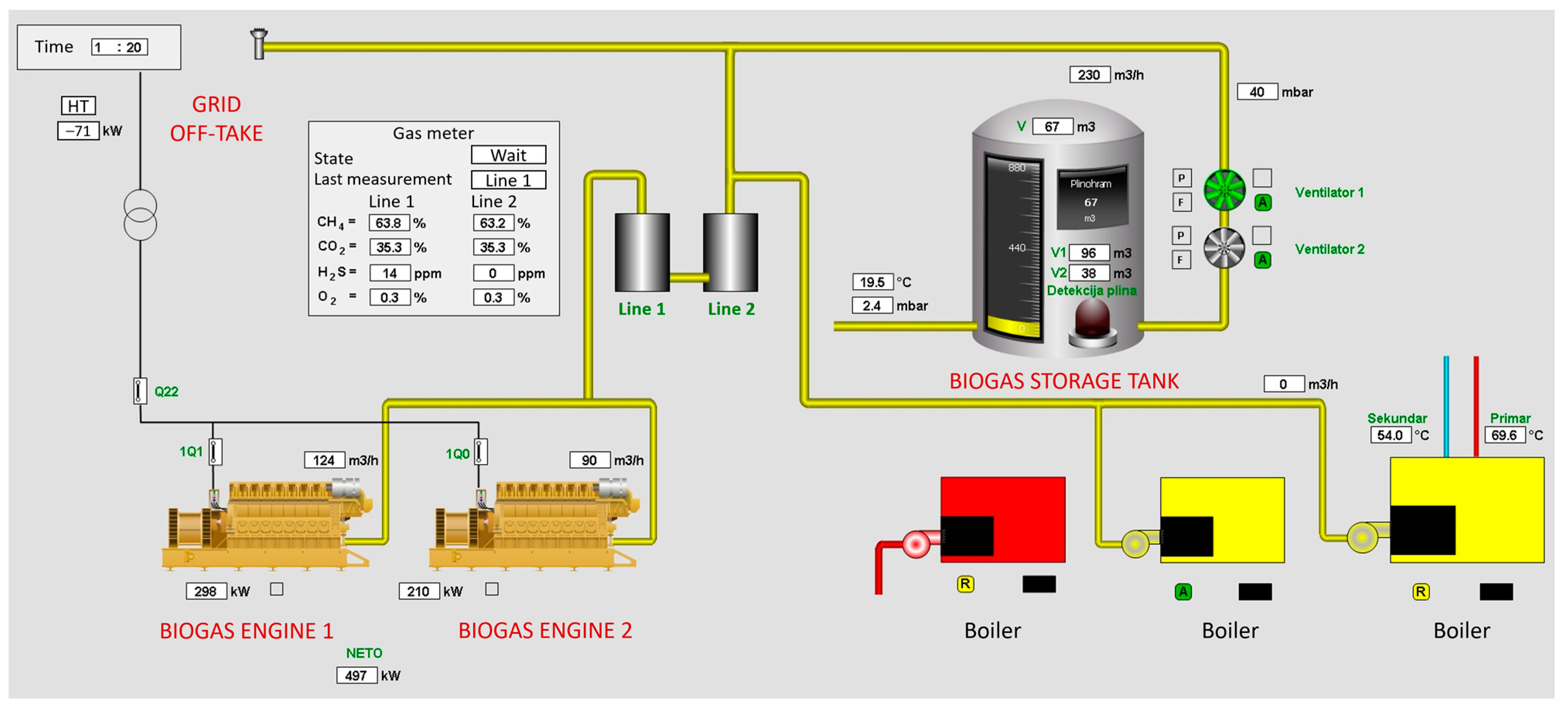

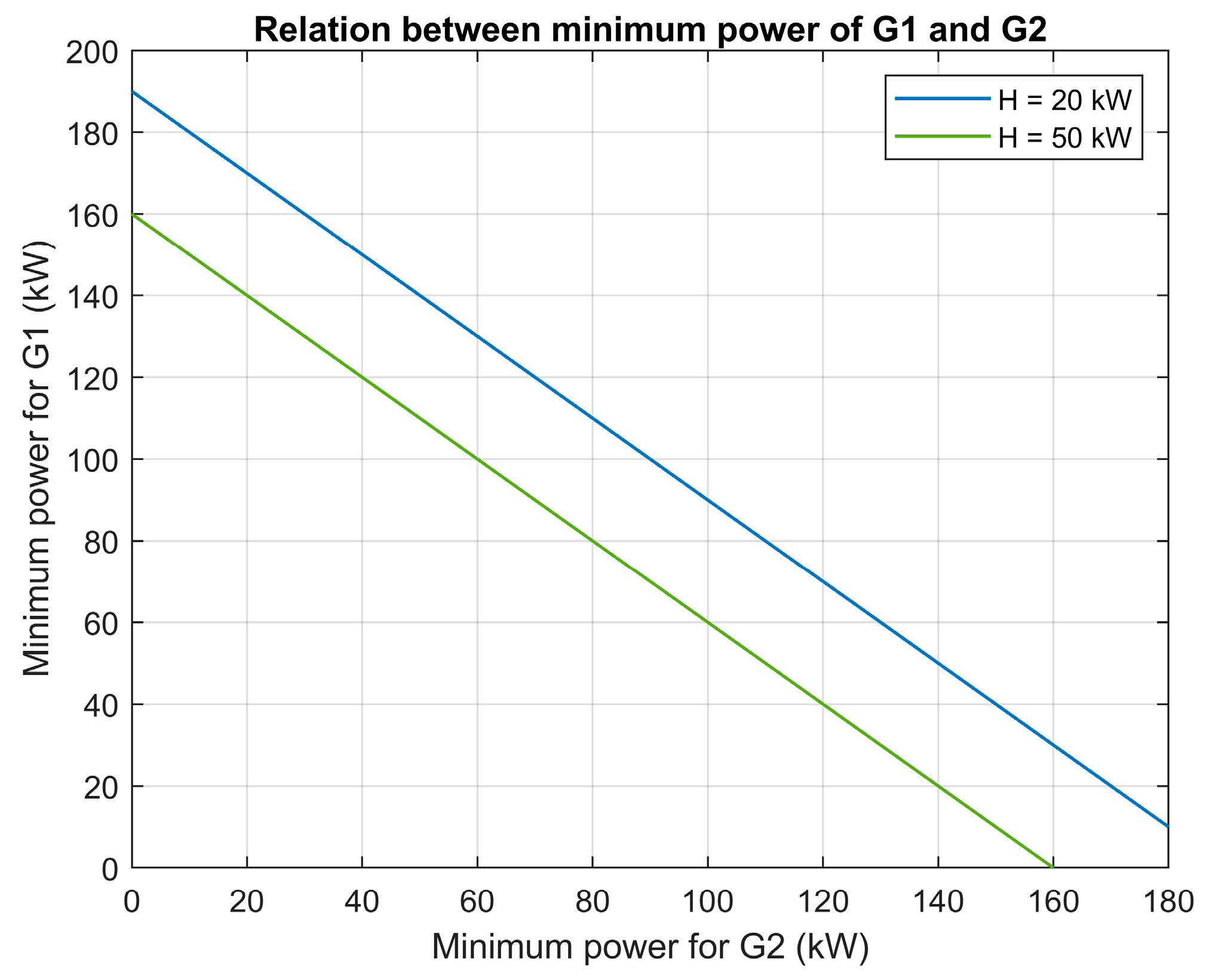
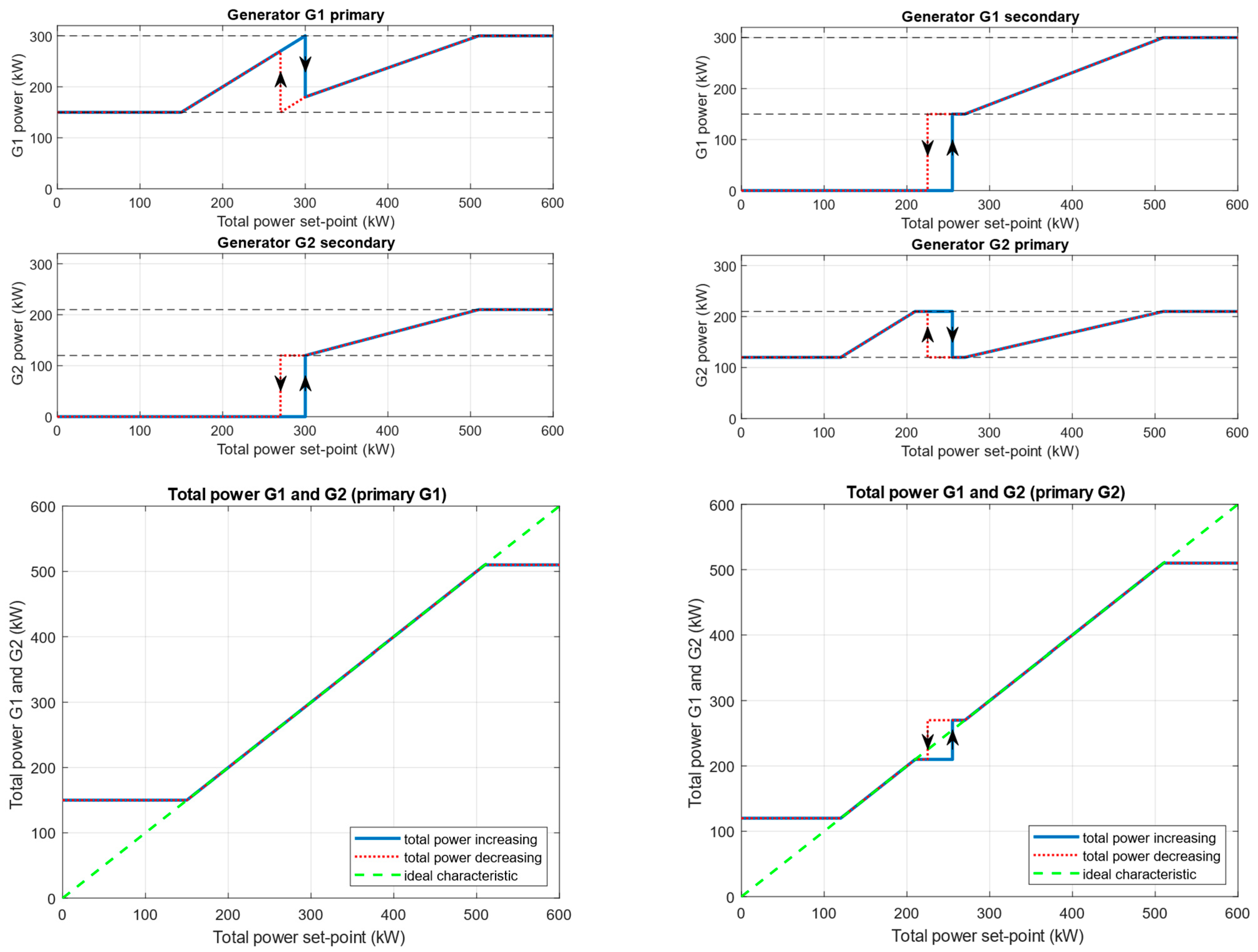

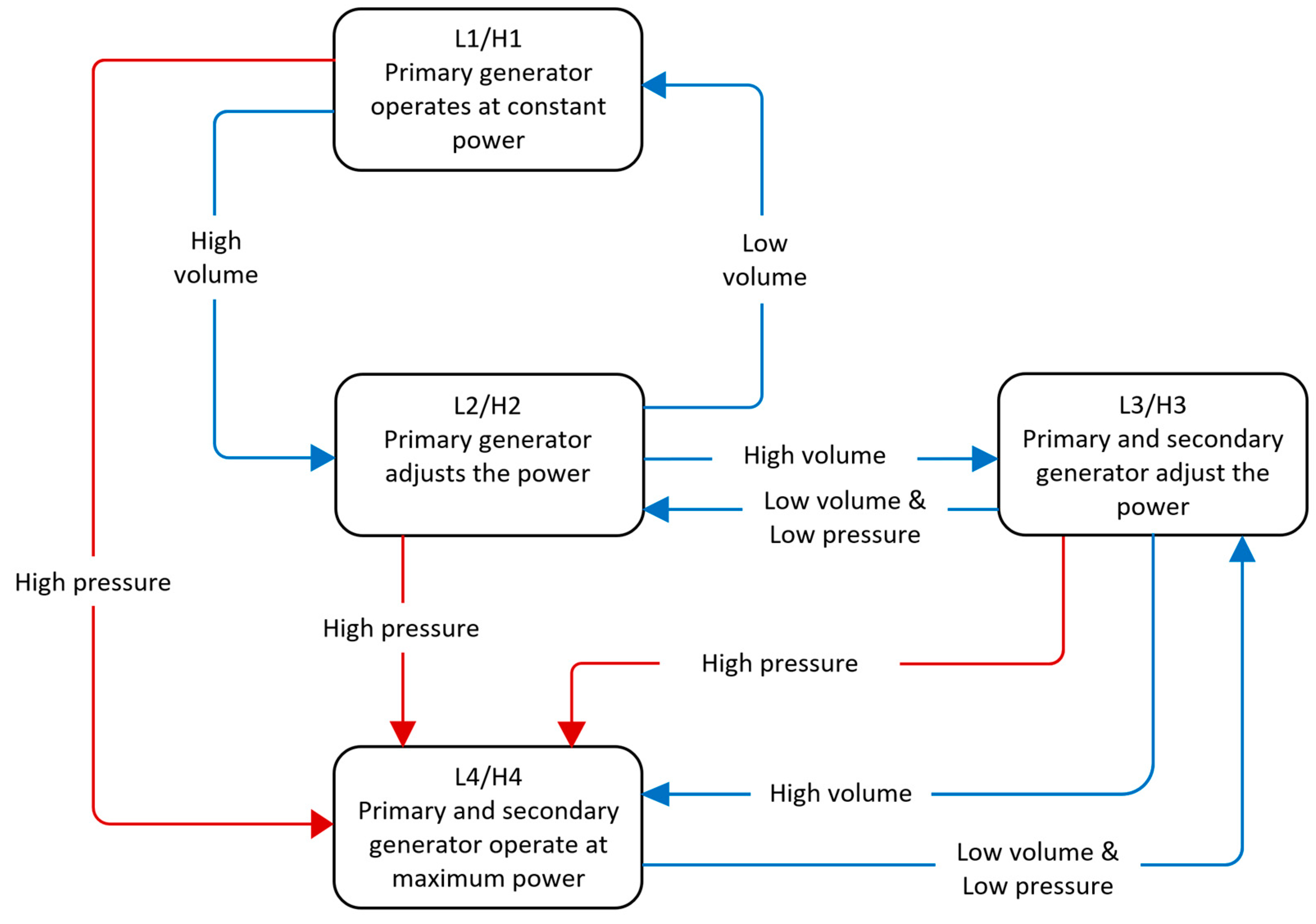
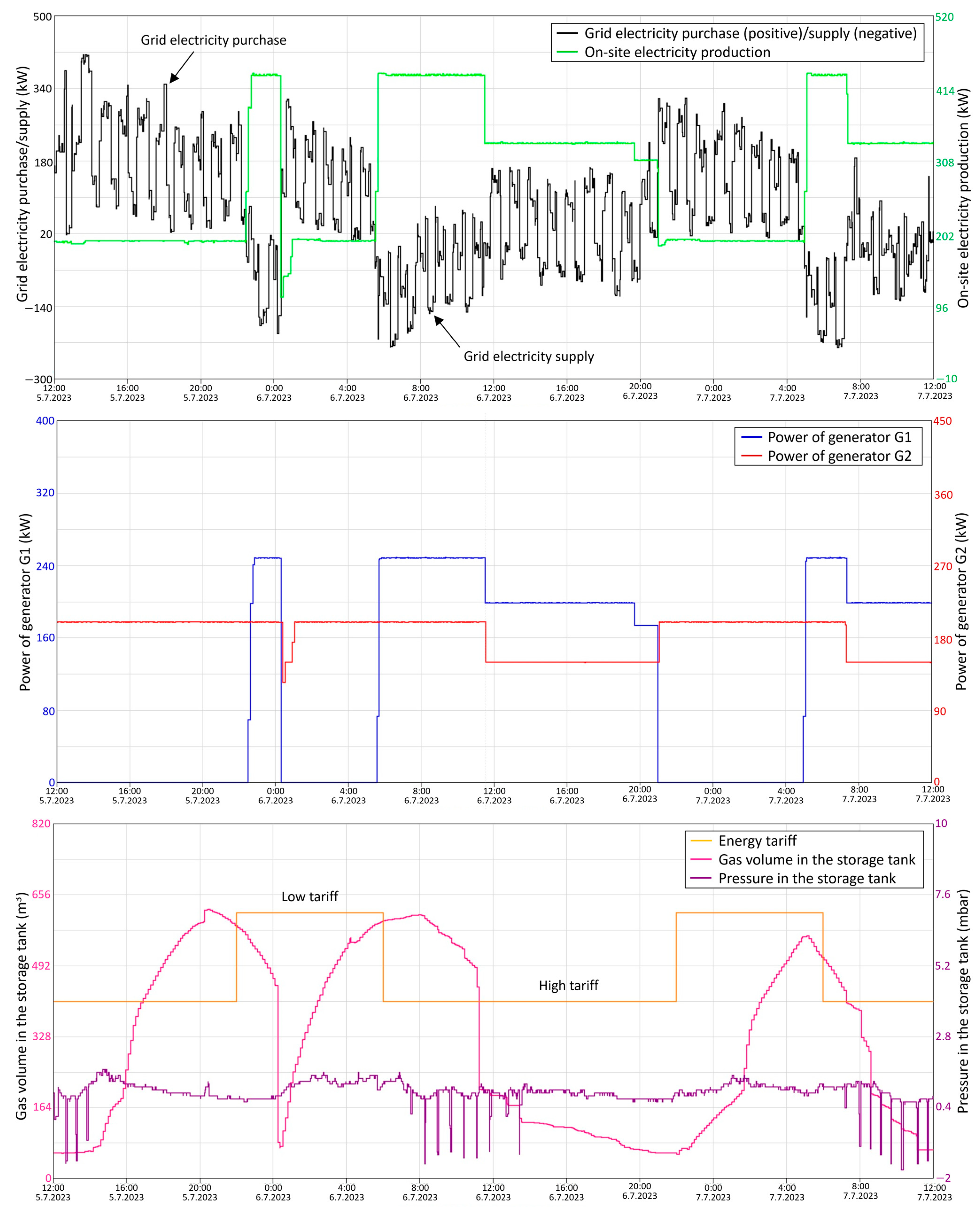
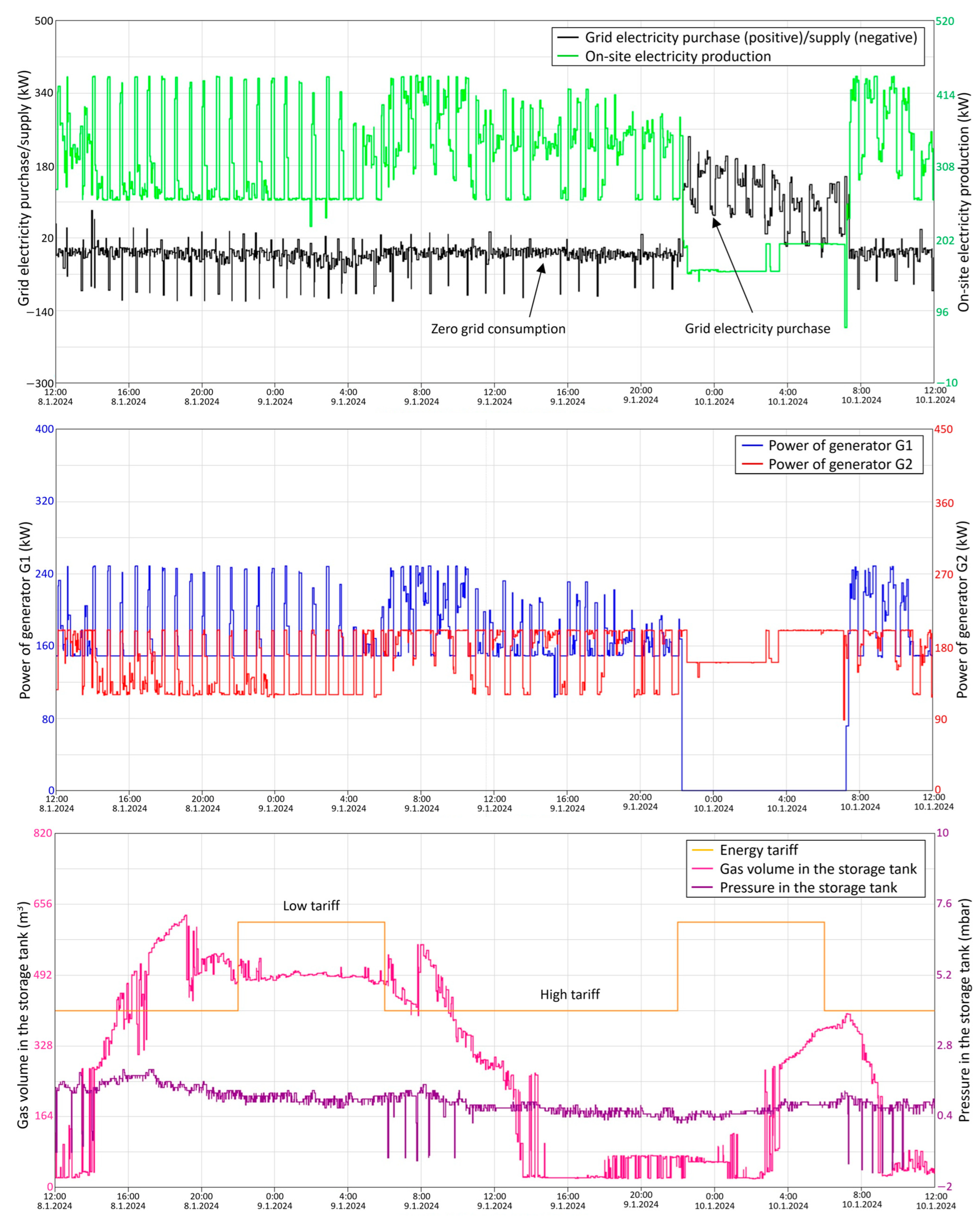
| Grid Electricity Purchase/Sale Compared to On-Site Generation | Low Tariff | High Tariff 1 |
|---|---|---|
| Grid purchase | 35% + grid fee | 76% + grid fee |
| Sales to grid | −18% | 22% |
| Parameters of the Implemented Control Algorithm | |||
|---|---|---|---|
| Volume transitions | |||
| L1 to L2 | >30% | L2 to L1 | <10% |
| L2 to L3 | >85% | L3 to L2 | <15% |
| L3 to L4 | >95% | L4 to L3 | <90% |
| H1 to H2 | >20% | H2 to H1 | <10% |
| H2 to H3 | >50% | H3 to H2 | <15% |
| H3 to H4 | >95% | H4 to H3 | <90% |
| Pressure transitions | |||
| Any state to L4 (or H4) | >2.5 mbar | ||
| L4 to L3 | <1.6 mbar | H4 to H3 | <1.6 mbar |
| L3 to L2 | <0.8 mbar | H3 to H2 | <0.8 mbar |
| Time for pressure transitions | |||
| Any state to L4 (or H4) | 2 min | ||
| L4 to L3 (or H4 to H3) | 10 min | ||
| L3 to L2 (or H3 to H2) | 15 min | ||
| Transition delay to a new state | |||
| Any state | 15 min | ||
| Factor kE | |||
| Low tariff | 1.0 | ||
| High tariff | 1.1 | ||
| Electricity Production and Consumption | Unit | Initial Operation January–June 2023 | Implemented Dynamic Control January–June 2024 |
|---|---|---|---|
| Total on-site electricity generation in biogas engines | kWh | 1,612,127 | 1,493,880 |
| Total electricity consumption at WWTP | kWh | 1,482,643 | 1,391,122 |
| Electricity supply to the grid (sell) | kWh | 309,203 | 200,949 |
| Electricity off-take from the grid (purchase) | kWh | 128,935 | 46,089 |
| Share of consumed electricity purchased from the grid | % | 8.7 | 3.3 |
Disclaimer/Publisher’s Note: The statements, opinions and data contained in all publications are solely those of the individual author(s) and contributor(s) and not of MDPI and/or the editor(s). MDPI and/or the editor(s) disclaim responsibility for any injury to people or property resulting from any ideas, methods, instructions or products referred to in the content. |
© 2025 by the authors. Licensee MDPI, Basel, Switzerland. This article is an open access article distributed under the terms and conditions of the Creative Commons Attribution (CC BY) license (https://creativecommons.org/licenses/by/4.0/).
Share and Cite
Hvala, N.; Vrečko, D.; Cerar, P.; Žefran, G.; Levstek, M.; Vrančić, D. Energy Cost Optimisation in a Wastewater Treatment Plant by Balancing On-Site Electricity Generation with Plant Demand. Water 2025, 17, 1170. https://doi.org/10.3390/w17081170
Hvala N, Vrečko D, Cerar P, Žefran G, Levstek M, Vrančić D. Energy Cost Optimisation in a Wastewater Treatment Plant by Balancing On-Site Electricity Generation with Plant Demand. Water. 2025; 17(8):1170. https://doi.org/10.3390/w17081170
Chicago/Turabian StyleHvala, Nadja, Darko Vrečko, Peter Cerar, Gregor Žefran, Marjetka Levstek, and Damir Vrančić. 2025. "Energy Cost Optimisation in a Wastewater Treatment Plant by Balancing On-Site Electricity Generation with Plant Demand" Water 17, no. 8: 1170. https://doi.org/10.3390/w17081170
APA StyleHvala, N., Vrečko, D., Cerar, P., Žefran, G., Levstek, M., & Vrančić, D. (2025). Energy Cost Optimisation in a Wastewater Treatment Plant by Balancing On-Site Electricity Generation with Plant Demand. Water, 17(8), 1170. https://doi.org/10.3390/w17081170







